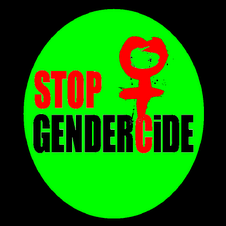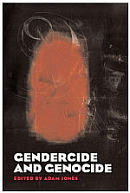In some ways, yes - in today's China. Perhaps 15 million female babies have 'gone missing' since China's 'one child policy' was introduced in 1979. A group of American charity fund-raisers with concealed cameras has uncovered 'silent slaughter' on a massive scale - in China's 'dying rooms'. The following are excerpts from 'The Dying Rooms' by Tom Hilditch, in the HK Sunday Morning Post Magazine, June 25, 1995, pp. 16-20: 'The aim of the documentary team, funded by Britain's Channel Four, was to explore persistent reports that some state-run Chinese orphanages leave baby girls to die of starvation and neglect... [Two years ago an investigation by SMP Magazine uncovered evidence in one orphanage] 'in Guangxi province... It was freely admitted [by staff and regular visitors] that 90 per cent of the 50 to 60 baby girls who arrived in the orphanage each month would end their lives there. 'The birth of a baby girl has never been a cause for celebration in China. In general, an infant boy will be greeted with firework displays and parties, a girl with silence. According to records there are currently six million women in China named Lai Di. The name means "a son follows quickly." '...Stories of peasant farmers drowning new-born girls in a bucket of water have been commonplace for centuries. Now, however, as a direct result of the one-child policy there are growing reports of infanticide all across China, including its towns and cities... [In China] 'a child is born every 1.5 seconds, 2,400 every hour, 21 million a year. In March 1995 President Jiang Zemin was forced to set new, tougher population controls and tougher punishments for those who ignore them. Couples who attempt to have more than one child will be dealt with brutally... 'Coerced abortions, sometimes just days before the baby is due, are now commonplace... 'In one orphanage... the infant inmates sit in bamboo benches in the middle of a courtyard. Their wrists and ankles are tied to the armrests and legs of the bench. They have been there all day unable to move. A row of plastic buckets is lined up beneath holes in their seats to catch their urine and excrement. The children will not be moved again until night when their benches will be carried back into their cot room and they will be lifted out and tied to their beds... 'They had no stimulation, nothing to play with, no one else to touch them. They have never known affection...' And so on. I have a friend who has visited one of these places. Children there are left without any clothing below the waist, in freezing temperatures. A mentally ill child was found sitting naked in a room in the freezing cold. My friend was allowed to hold a few babies while they died... Shalom! Rowland Croucher
--------------------------------------------------------------------------------
Two years ago, the Sunday Morning Post reported on the outrage of healthy baby girls left to die in China's orphanages, victims of the one-child policy. Now, as a British documentary team has discovered, the problem is getting worse. TOM HILDITCH reports. MEI-MING has lain this way for 10 days now: tied up in urine-soaked blankets, scabs of dried mucus growing across her eyes, her face shrinking to a skull, malnutrition slowly shrivelling her two-year-old body. Each morning a fellow inmate at her Guangdong orphanage goes into the dark fetid room where she lies alone to see if she is dead. The orphanage staff, paid to look after her, do not visit. They call her room the "dying room" and they have abandoned her there for the same reason her parents abandoned her shortly after she was born. Her problem is simple and tragic: she has a condition which in modern China makes her next to useless, a burden on the state with an almost zero chance of adoption. She is a girl. When she dies in four days later it will not be of some terminal, incurable illness. It will be of sheer neglect. Afterwards the orphanage will dispose of her desiccated corpse and deny she ever existed. She will be just another invisible victim of the collision between China's one-child policy and its traditional preference for male heirs. The name the orphanage gave her articulates precisely the futility of struggle to survive in a society that holds no value for her. In Putonghua, Mei-ming means 'no name'. She is one of perhaps 15 million female babies who have gone missing from China's demographics since the one child per family policy was introduced in 1979. Another tiny bag of bones in what some sinologists claim is the 20th century's hidden holocaust. Yet her brief and miserable life may not have been in vain. Before she died she was discovered by a British documentary team who entered her orphanage posing as American charity fund-raisers. The footage they shot, through a concealed camera, would provide the first video evidence of the existence of dying rooms. And when their documentary was shown 13 days ago, against the protestations of China's London embassy, little Mei-ming's dying cries for help were heard around the world. The aim of the documentary team, funded by Britain's Channel Four, was to explore persistent reports that some state-run Chinese orphanages leave baby girls to die of starvation and neglect. Their starting point was the Sunday Morning Post's award-winning investigation of two years ago which gave the world the first eye-witness and photographic evidence of dying rooms at Nanning orphanage, in Guangxi province. Then the dying room was spoken of openly by staff and regular visitors. It was freely admitted that 90 per cent of the 50 to 60 baby girls who arrived at the orphanage each month would end their lives there. Since the outrage provoked by our report, however, Nanning orphanage has been overhauled. Money raised by Hong Kong celebrities has upgraded facilities and the quality of care. The dying rooms there have ceased to exist. Sadly, after touring and filming in orphanages in four provinces, the British documentary team's harrowing report suggests that the attitudes towards baby girls so prevalent at Nanning two years ago are rife elsewhere. The birth of a baby girl has never been a cause for celebration in China. In general, an infant boy will be greeted with firework displays and parties; a girl with silence. According to records there are currently six million women in China christened Lai Di. The name means "a son follows quickly". Tradition dictates that when a daughter marries she will join her husband's family, her children will take his family name and she must support his parents in their old age. In rural areas, female infants are simply a drain on resources. They are referred to as "maggots in the rice". Stories of peasant farmers drowning new-born girls in a bucket of water have been commonplace for centuries. Now, however, as a direct result of the one-child policy there are growing reports of infanticide all across China, including its towns and cities. The numbers of baby girls being abandoned, aborted or dumped on orphanage steps is unprecedented. It is impossible to understate both how crucial the one-child policy is to China's stability and how rigidly it is enforced. Everyone - the World Bank, the United Nations, China's own statisticians - agrees that if the population, already at 1.2 billion, is allowed to grow, China will be unable to support itself, let alone develop. The result would be economic collapse, environmental ruin, famine. But while most Chinese can accept the mathematics of the problem, many cannot accept the draconian mechanics of the solution. The population continues to rise. A child is born every 1.5 seconds, 2,400 every hour, 21 million a year. In March 1995 President Jiang Zemin was forced to set new, tougher population controls and tougher punishments for those who ignore them. Couples who attempt to have more than one child will be dealt with brutally. According to Steven Mosher, the author of A Mother's Ordeal, coerced abortions, sometimes just days before the baby is due, are now commonplace. As are reports of enforced sterilisation and of hospitals fatally injecting second babies shortly after their birth. "It means tremendous coercion," he says, "on women to submit to abortion and sterilisation. It also means that however overcrowded China's orphanages are now with baby girls, the problem is going to get worse. Very much worse." For Kate Blewett, producer of the Channel Four documentary The Dying Rooms, the investigation was a journey into the heart of darkness. "I did not know that human beings could treat children with such contempt, such cruelty. It is not so much a problem of the orphanages being underfunded as it is a problem of attitude towards unwanted babies. Some of the orphanages we visited were little more than death camps. We filmed treatment that amounted to torture, conscious neglect that amounted to murder." Travelling in China with hidden cameras and under false pretences meant Blewett and her team were in danger of being arrested every step of the way. The risk for local Chinese who helped them gain access to orphanages and those she interviewed, unwittingly or otherwise, was even greater. For that reason the documentary does not name any of the orphanages or identify mainland interviewees. Nonetheless, the harrowing squalor of conditions is there for all to see. In one orphanage a dozen or so baby girls are supervised by an adolescent girl in a white coat. As the team walk in she ignores them and goes out of the room, leaving a mentally handicapped child to show them around. The infant inmates sit in bamboo benches in the middle of a courtyard. Their wrists and ankles are tied to the armrests and legs of the bench. They have been there all day unable to move. A row of plastic buckets is lined up beneath holes in their seats to catch their urine and excrement. The children will not be moved again until night when their benches will be carried back into their cot room and they will be lifted out and tied to their beds. "It was heart-breaking," said Blewett. "They had no stimulation, nothing to play with, no one to touch them. They have never known affection. In one scene shown in the documentary one of the handicapped older boys walks up to one of the girls tied to a bench and begins head-butting her. He butts her relentlessly. It goes on and on. But the girl doesn't move or make a sound. Such is the lack of stimulation for the children that the one thing they all have in common is an endless rocking. They sit tied to their potty chairs rocking backwards and forwards and screaming. Few of them will ever learn to speak and the rocking is the only exercise, the only stimulation, the only pleasure in their lives." Presently the teenager in the white coat returns with an official of the orphanage. He buys Blewett's cover story and, seduced by the suggestion of foreign funds, he agrees to by interviewed. His monologue is chilling. Last year, he says, the orphanage had some 400 inmates. They were all kept five to a bed in one airless room. The summer temperatures soared above 37 degrees Celsius. Disease swept throught the room. In a couple of weeks 20 per cent of the babies died. Later, Blewett trains her camera on another of the assistants. "If 80 children died last summer, there should be 320 left," Blewett says, "but there don't appear to be more than a couple of dozen children here. Where are the others?" "They disappear," the girl replies. "If I ask where they go, I am just told they die. That's all. I am afraid to ask any more." Brutal neglect is the common theme of many of the orphanage scenes. In one sequence a lame child sits on a bench near the orphanage pharmacy. It is stocked full of medicines but none of the staff can be bothered to administer them. The child rocks listlessly back and forth as staff wander. The camera focuses on her vacant face, trails down her skinny body and settles on her leg... it is swollen with gangrene. Such institutionalised cruelty and neglect was in no way limited to rural areas. The worst orphanage, the brief home of Mei-ming, was in Guangdong, one of the richest provinces in China. When they arrived the documentary makers wondered at first whether they had made a mistake. There were no children to be seen or heard. Then from under one of the blankets laid over a cot, as if left to dry out, there was the sound of crying. Lifting the blanket and unwrapping a tied bundle of cloth, Blewett found a baby girl. The last layer of her swaddling was a plastic bag filled with urine and faeces. The next cot was the same, and the next and the next. Many of the children had deep lesions where the string they were tied with had cut into their bodies. One child, described by staff as "normal", was suffering from vitamin B and C deficiency, acute liver failure and severe impetigo on her scalp. As always, Blewett made a point of checking the babies' gender. As always, all the non-handicapped children were girls. The Chinese Government was approached several times both in Beijing and at its London embassy to provide comment or an interview for inclusion in the film. The Government was given a three-month deadline but remained silent. Then it was given a 10-day extension. On the ninth day Channel Four received a two-page letter from the London embassy. It became the final sequence of the film. "The so-called 'dying rooms' do not exist in China at all", read the statement's penultimate paragraph. "Our investigations confirm that those reports are vicious fabrications made out of ulterior motives. The contemptible lie about China's welfare work in orphanages cannot but arouse the indignation of the Chinese people, especially the great numbers of social workers who are working hard for children's welfare." The statement was followed by diplomatic representations to have the station drop the documentary. Channel Four refused. The programme which was transmitted on June 12 and dedicated to Mei-ming created enormous publicity. The following day questions were raised in the House of Commons about China's one-child policy and its dying rooms. Efforts are now being made by, among others, MP Anne Winterton, to bring about diplomatic pressure to halt China's one-child policy. Predictably, however, no one has raised the subject of providing massive aid for a collapsed and famine-ridden China in the event of its population rising to, say, 2.4 billion if this generation is allowed to have two children per family. More practically, however, Blewett and her team have set up a fund, The Dying Rooms Trust, to make contributions to international charities working with Chinese orphanages, to help purchase and distribute milk powder, play-pens and basic medicines to the orphanages featured in the documentary and establish sponsorship systems for their inmates. "We don't want to criticise the one-child policy," says Blewett. "But we do want to focus on the problems it is causing which can be solved." The documentary features a tour of a privately-run, locally funded orphanage where the children are happy, healthy and loved. "We were very keen to show what can be done with the right attitude," said Blewett. "No child should suffer the kind of neglect we filmed. Maybe we can help that happen. Maybe then, Mei-ming's life might have had some purpose." The programme is unlikely to be shown in Hong Kong.
For more information contact: The Dying Room Trust, 68 Thames Road, London W4 3RE. Cheques should be made payable to The Dying Rooms. Sunday Morning Post Magazine, June 25, 1995.
© John Mark Ministries. Articles may be reproduced in any medium, without applying for permission
Subscribe to:
Post Comments (Atom)












No comments:
Post a Comment